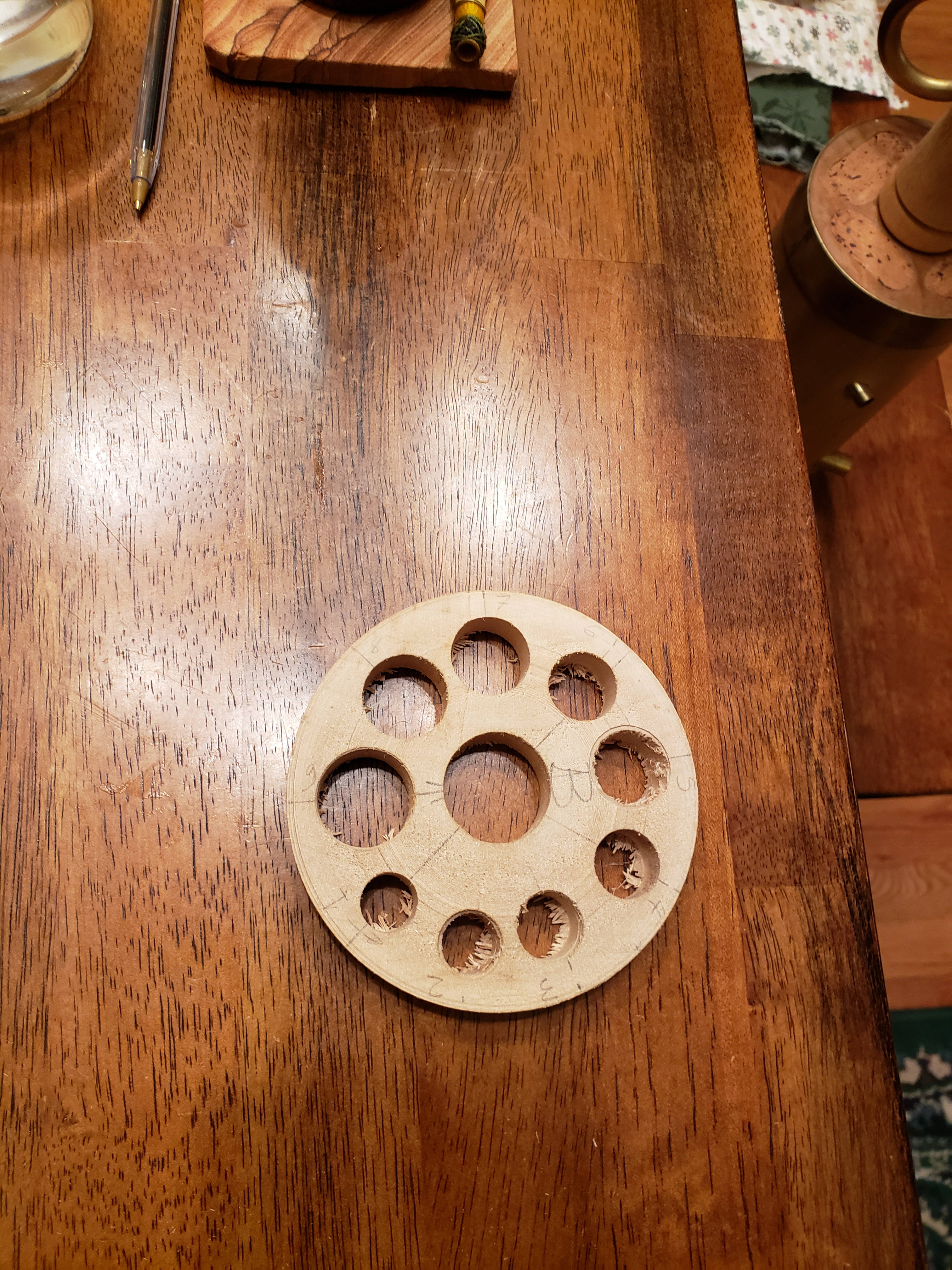Raw Materials: A block
of maple,
some brass tube for the reed staple and some rather large reed
cane. Workshop drawings from the Toronto consort series published in
the 1970's gave the basic dimensions and instructions for construction
of a quint-bass rackett, which was the first rackett project attempted.
"Quint-bass" means that the pitch is a 5th below the pitch of typical
bass instruments such as dulcians, with a basic scale of F
Detail of the pirouette and the interconnected 8 peripheral bores. Many modern racketts fail to copy the elegant design of the pirouette of the old instruments, presumably due to the expense and effort to get the turning right and the cutting of the long decorative slots in the side. The pirouette actually helps to focus and augment the sound as it allows a very relaxed style of embouchure. The bores are connected below the surface of the end by cross-cut channels across the septums between them. The wooden plugs in the end of the bores are only a few mm deep. As the cross-cut channel depths were later cut deeper to adjust tuning, the narrow bridged between the bores were cut away and the end plugs were made to span across neighboring bores.
By some mystery, the drawings intended to
produce a quint-bass
rackett ended up coming out rather sharp; the instrument was much
nearer a quart-bass (sounding a 4th lower than normal bass
instruments), than a quint bass. So the cross channels between the
bores were cut somewhat deeper, to raise the pitch to make the
instrument a genuine quart-bass.
This picture nicely shows the compact size of the finished quart-bass
rackett.
The instrument plays down to GG
below the bass clef.. The "7 finger" note is CC.
The fingerhole pattern could not be scaled up exactly as that would have made for an impossible stretch for the hands so some reorganization was required. Some educated guesswork was needed for this and quite a lot of tinkering and trial and error. The central feature of the Leipzig rackett was copied; that is the arrangement of multiple holes between the bores controlled by each of the two hands to get the "spacing" between the 2 hands correct. This scaled up quite well. This picture shows the 2 racketts and their size relative to a foot rule. The great-bass instrument could be made somewhat smaller by an inch or so, and a little thinner; with the initial guess of the scaling it came out rather flat, and needed rather deep end caps and bore cross-cuts. It however does sound rather well.
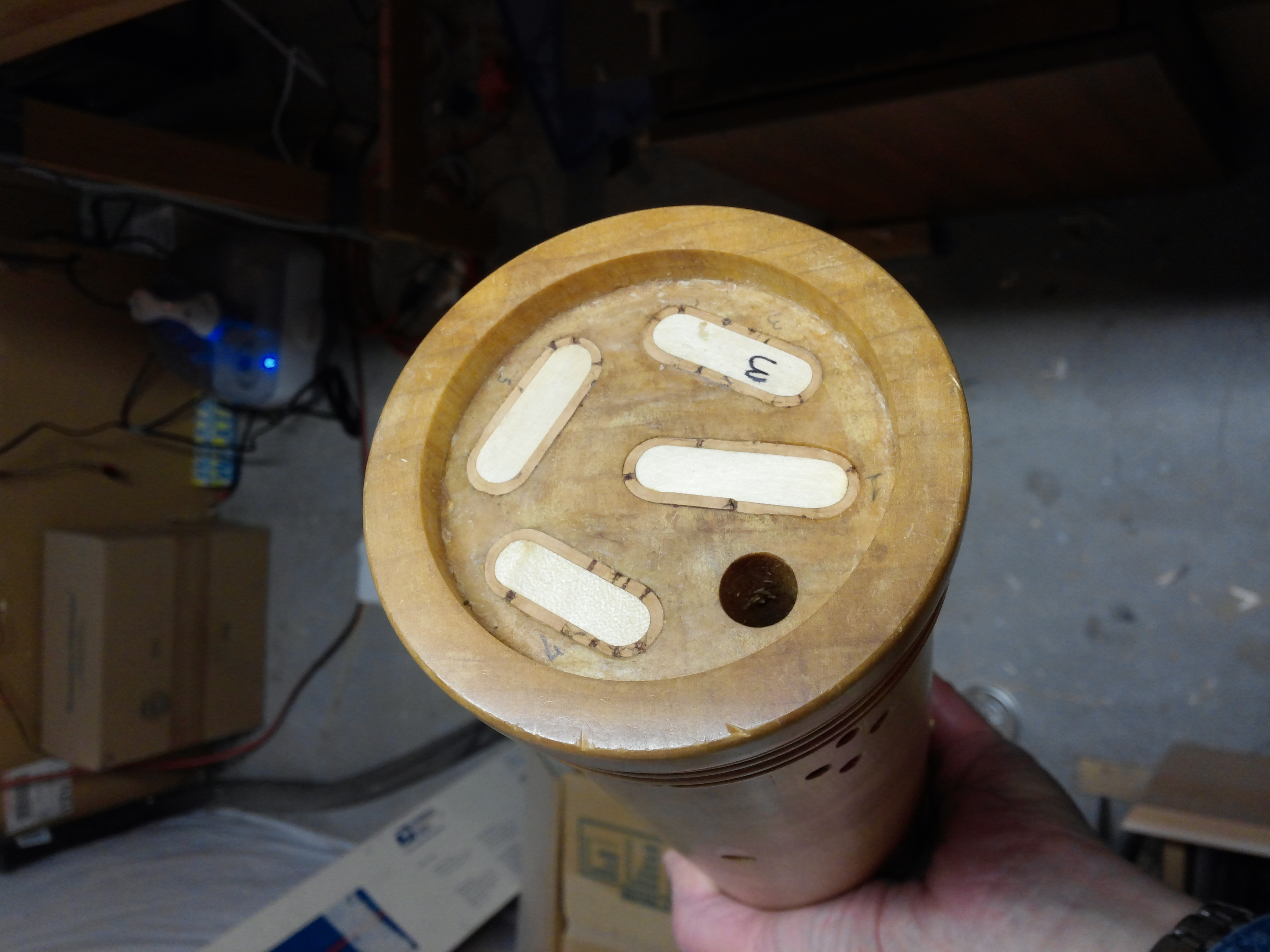 The
bottom plugs of the octave bass. These plugs were big enough
to
make of wood with cork glued round the edge. Smaller instruments have
plugs just made from solid cork. The open hole is the bottom
of
the 9th bore. A wooden disk is pressed into place in the
recess
to hide the plugs.
The
bottom plugs of the octave bass. These plugs were big enough
to
make of wood with cork glued round the edge. Smaller instruments have
plugs just made from solid cork. The open hole is the bottom
of
the 9th bore. A wooden disk is pressed into place in the
recess
to hide the plugs.
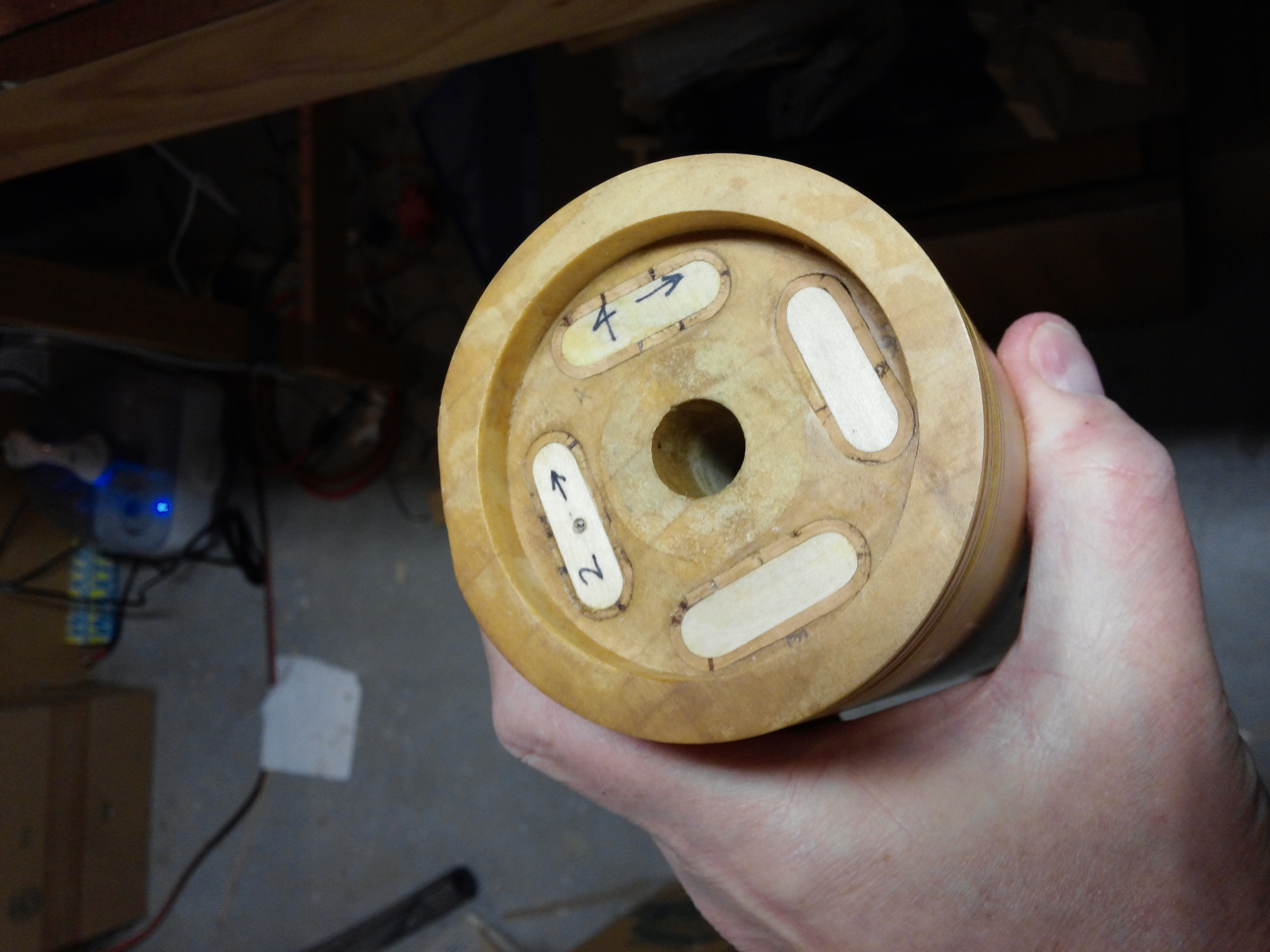 Here
is a view looking down from the top. Again when the instrument is
finished a decorative wood disk hides the plugs.
Here
is a view looking down from the top. Again when the instrument is
finished a decorative wood disk hides the plugs.\
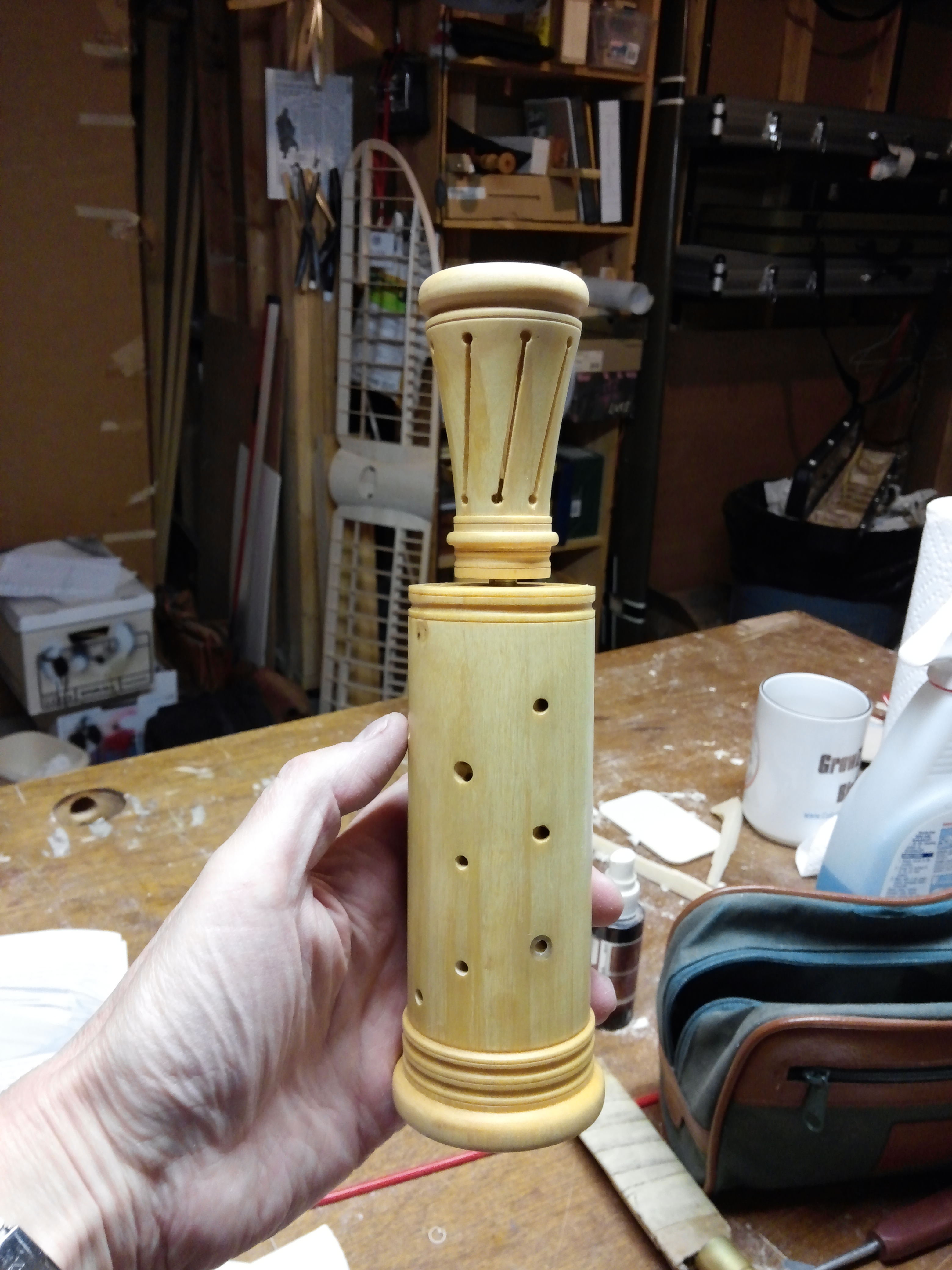 Somewhat
later I scaled the drawings to produce a regular bass
racket in F. This instrument is about the size of a coke
can. Here
are front and rear views of the bass in F - the bottom note is the same
CC at the bottom of the cello range.This is the handiest size for
players with small hands, as the low CC hole is hard to reach.
The basic 7 finger scale is like a bass recorder, the only
difference being that you have to use right thumb for the highest g
hole; your left hand hand does the notes c-f.
Somewhat
later I scaled the drawings to produce a regular bass
racket in F. This instrument is about the size of a coke
can. Here
are front and rear views of the bass in F - the bottom note is the same
CC at the bottom of the cello range.This is the handiest size for
players with small hands, as the low CC hole is hard to reach.
The basic 7 finger scale is like a bass recorder, the only
difference being that you have to use right thumb for the highest g
hole; your left hand hand does the notes c-f.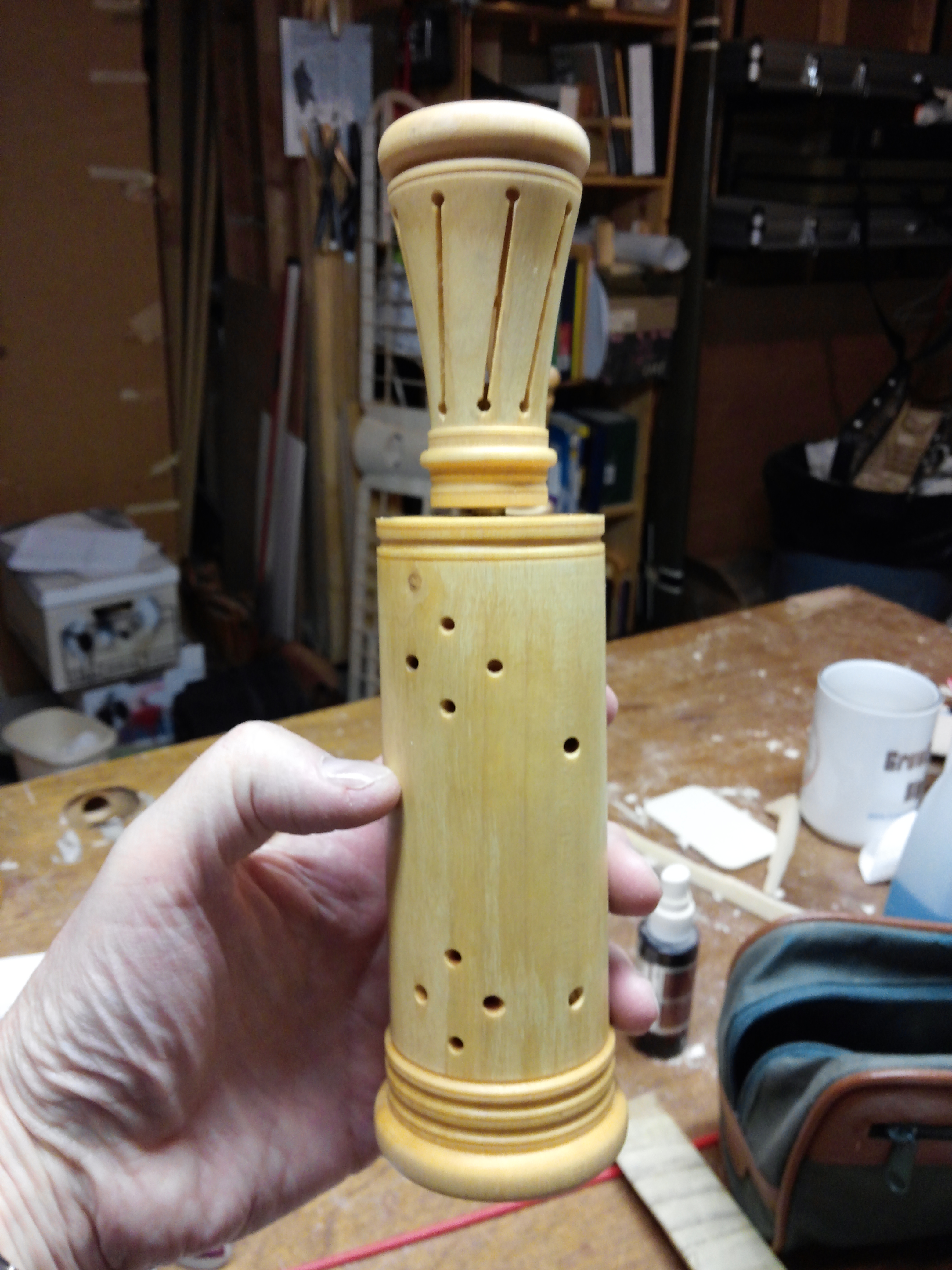 The
hole arrangement on the rear of the instrument - some are blind and
some are functional. This seems to have been done as as sort of riddle
to confuse the novice player or the uninitiated, or else it was just
done as a playful visual decoration. If you look carefully at the
Praetorius drawings you can see similar hole patterns depicted.
The
hole arrangement on the rear of the instrument - some are blind and
some are functional. This seems to have been done as as sort of riddle
to confuse the novice player or the uninitiated, or else it was just
done as a playful visual decoration. If you look carefully at the
Praetorius drawings you can see similar hole patterns depicted.
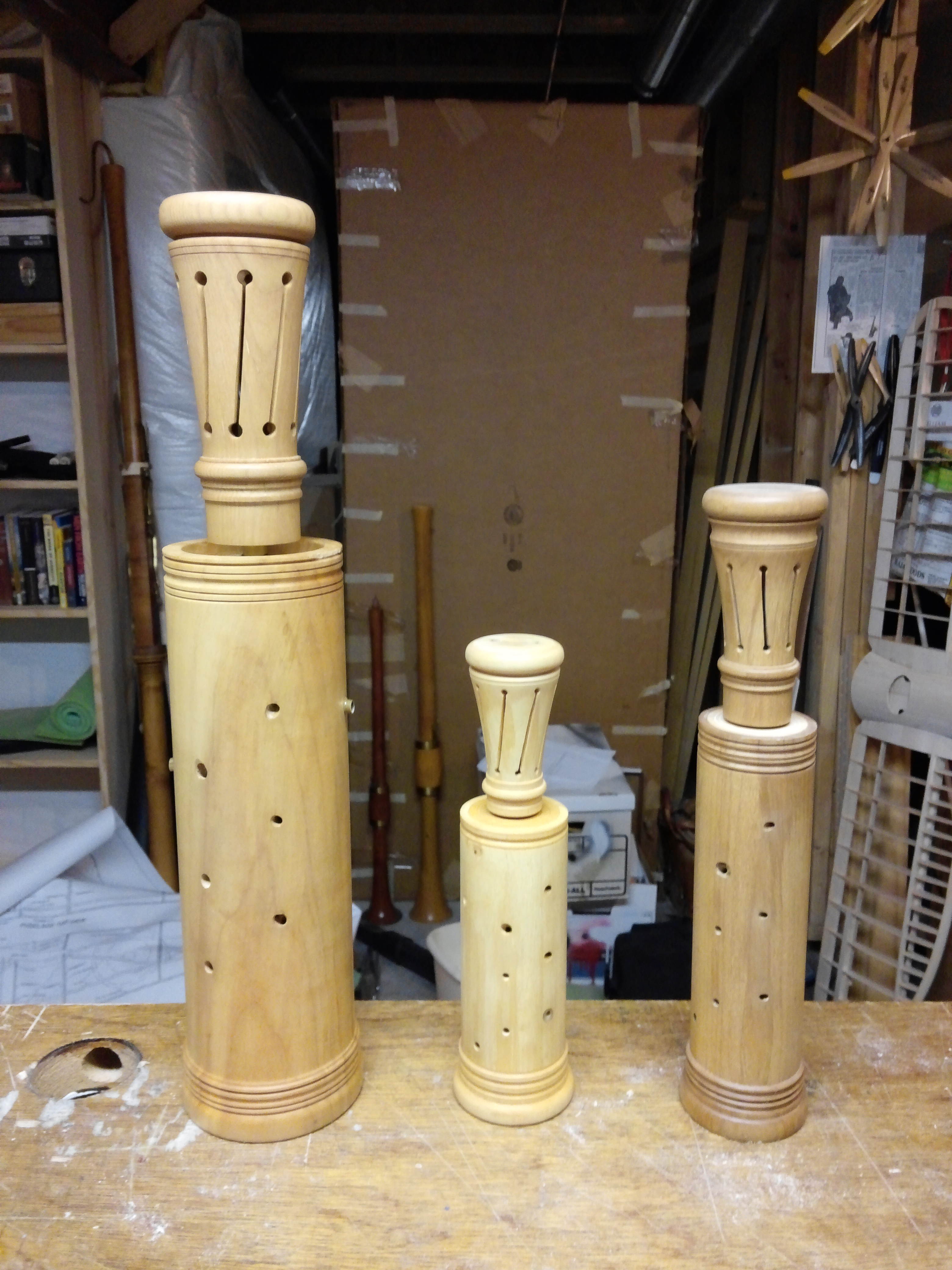 Here
is a picture of the 3 sizes together. Never mind the chaos in the
background.. If you look carefully at the octave bass you can see I
fitted brass "tetines" as Mersenne calls them to aid locating and
sealing holes which are stopped by the first joint of right and left
hands. Because of the large diameter with the octave bass the top hole
for g is closed by the finger joint. Because this arrangement is
different from the other two this makes switching sizes in a hurry
under field conditions quite taxing.
Here
is a picture of the 3 sizes together. Never mind the chaos in the
background.. If you look carefully at the octave bass you can see I
fitted brass "tetines" as Mersenne calls them to aid locating and
sealing holes which are stopped by the first joint of right and left
hands. Because of the large diameter with the octave bass the top hole
for g is closed by the finger joint. Because this arrangement is
different from the other two this makes switching sizes in a hurry
under field conditions quite taxing.The sound of the rackett: "Nasce la pena mia" by Alessandro Striggio. Play Piece This is played on 6 recorders and the bass is doubled by the quart rackett.This is the most effective use of the rackett to supply a low voice under a consort of other instruments. Praetorius says racketts played in consort "lack grace".
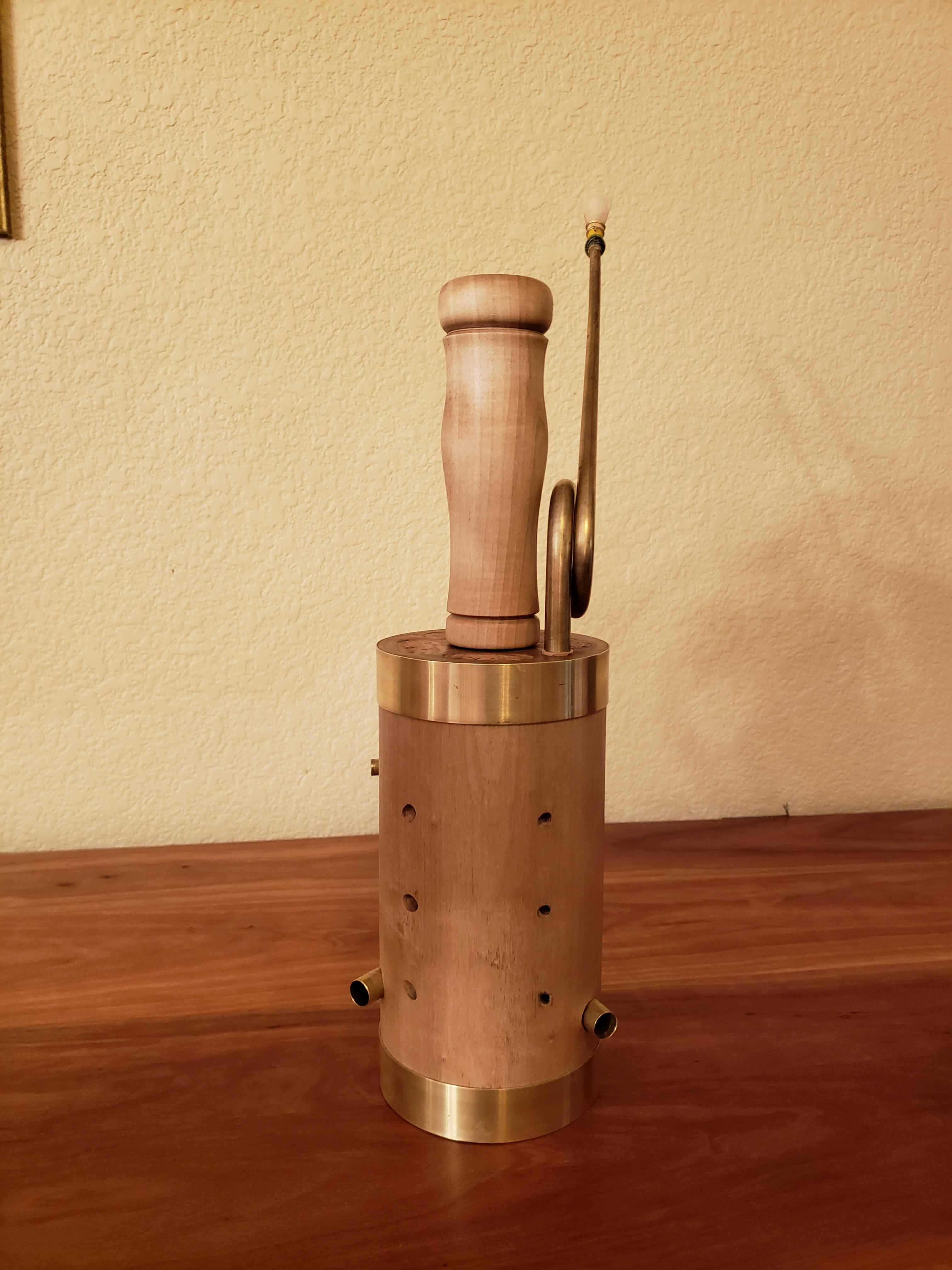
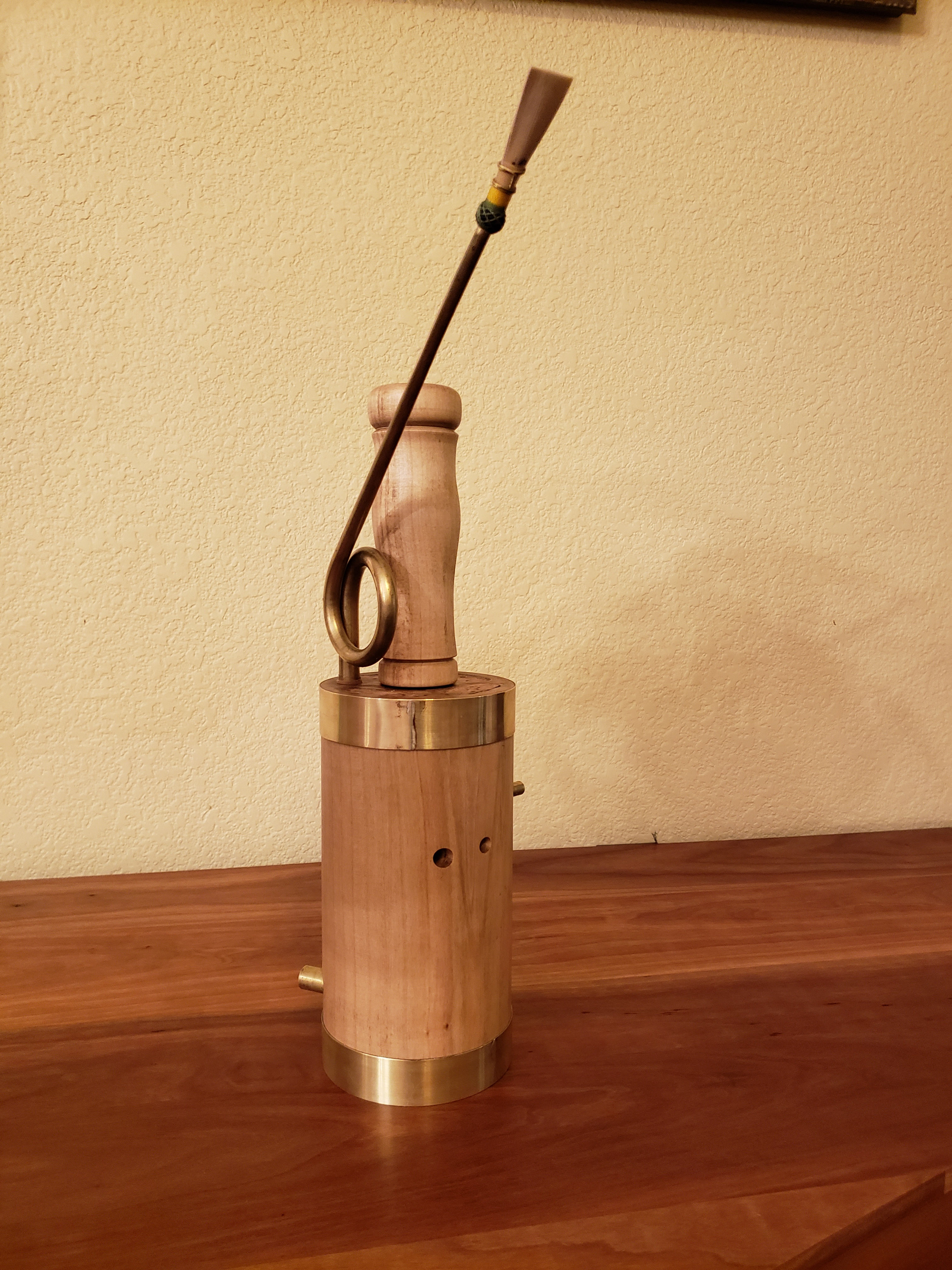 I
was fortunate to be able to buy 2 crooks for the instrument from the
dissolving of the Moeck factory stock. Hence I avoided making crooks
for myself. The crooks are quite a lot shorter than the original with
the instrument, which implies the original was played at a lower pitch.
With the crooks I bought, the instrument plays more or less as A440,
but obviously the linear proportions along the bore of the holes are
quite different. Fortunately the bassoon acoustically plays quite a lot
as a "volume" as opposed to a "pipe" so the tuning is not bad at A440.
I
was fortunate to be able to buy 2 crooks for the instrument from the
dissolving of the Moeck factory stock. Hence I avoided making crooks
for myself. The crooks are quite a lot shorter than the original with
the instrument, which implies the original was played at a lower pitch.
With the crooks I bought, the instrument plays more or less as A440,
but obviously the linear proportions along the bore of the holes are
quite different. Fortunately the bassoon acoustically plays quite a lot
as a "volume" as opposed to a "pipe" so the tuning is not bad at A440.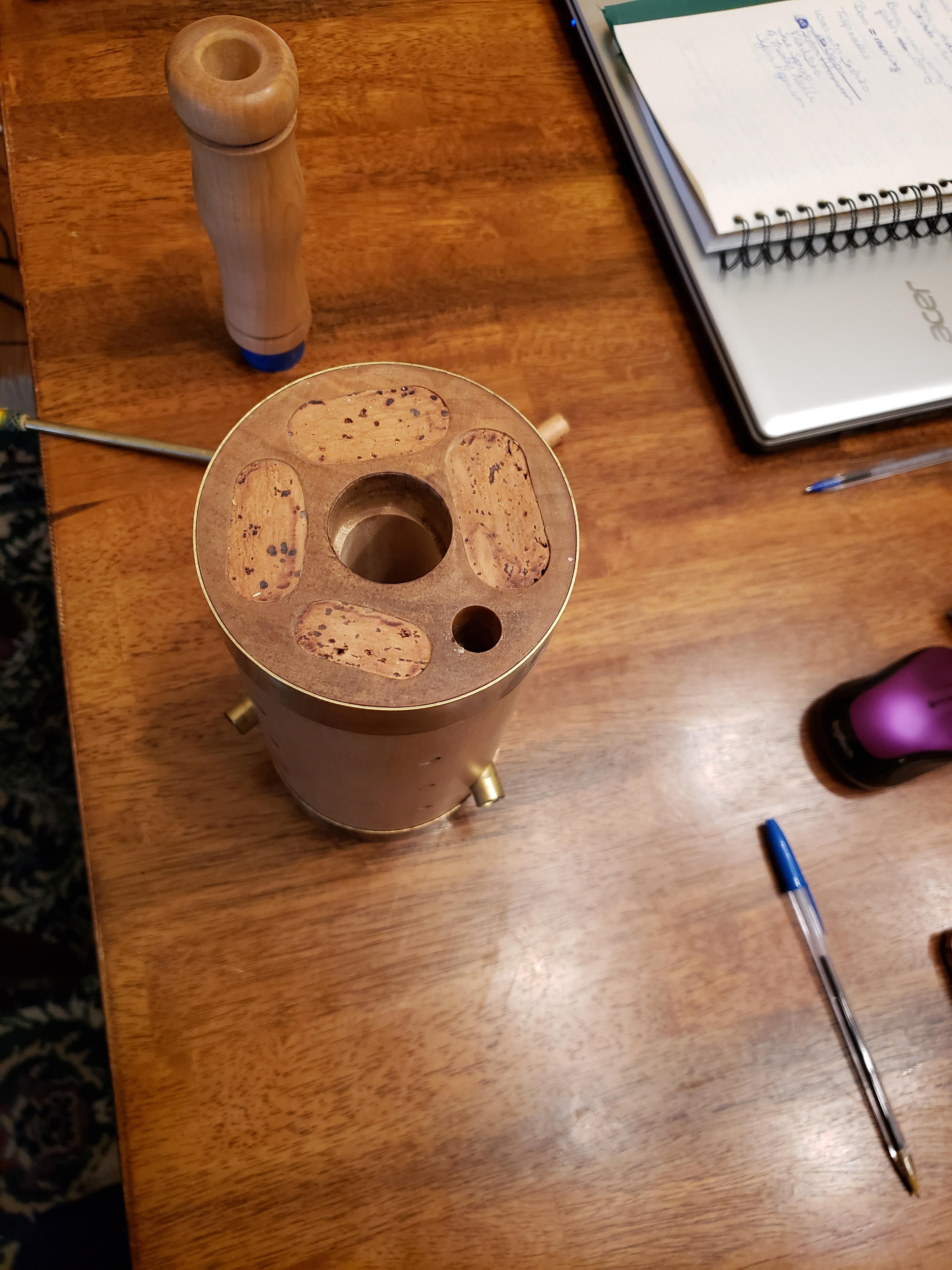 The
baroque rackett has an expanding bore. This makes a bassoon pitched
instrument about 2 times the size of the equivalent cylindrically
The
baroque rackett has an expanding bore. This makes a bassoon pitched
instrument about 2 times the size of the equivalent cylindrically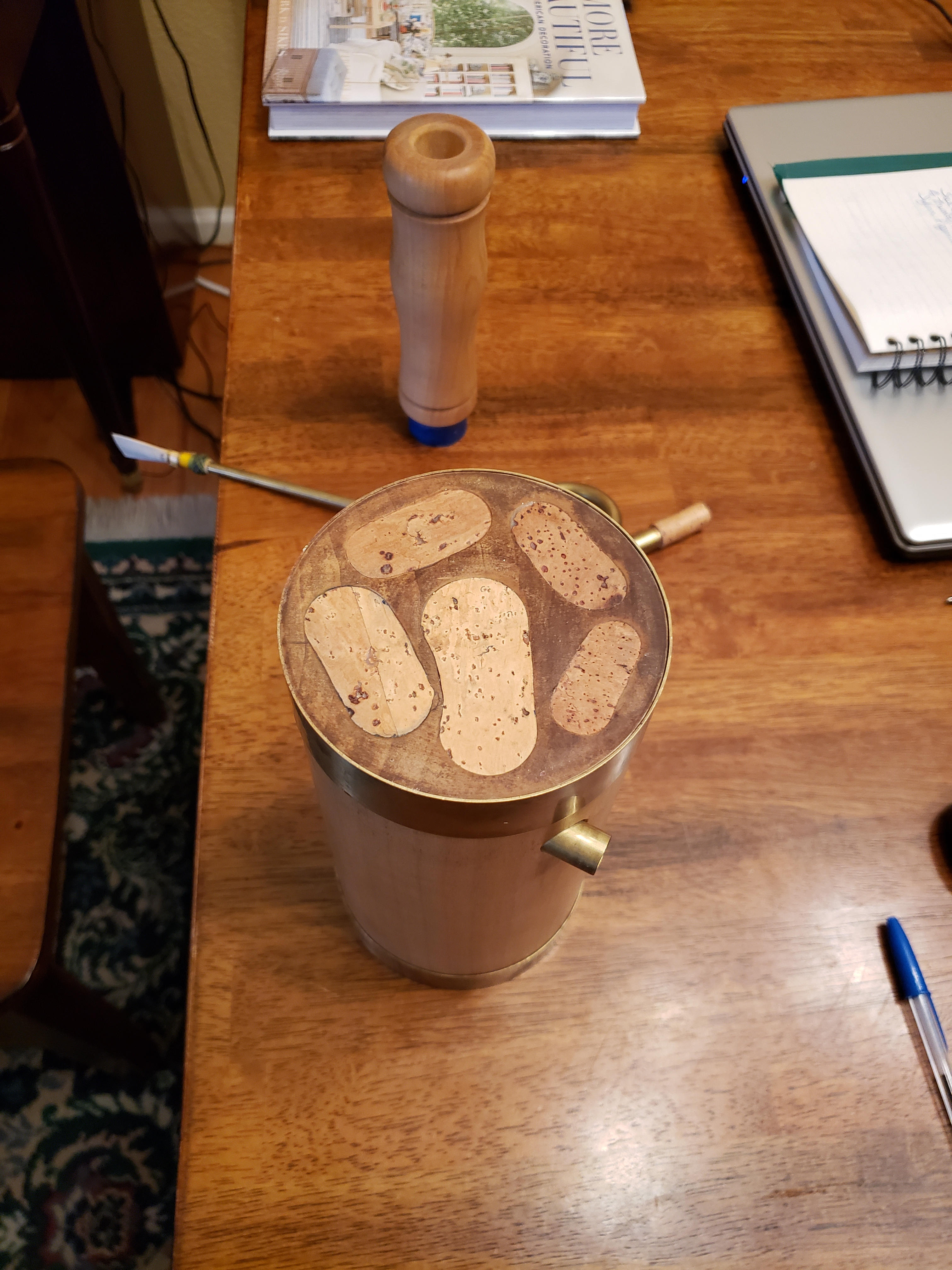 The
principle of multiple bores is taken 1 bore further so there are 10
bores now. This can be seen clearly in the cross section I sliced off
the end after drilling the body over length. In the bottom view
here you can see there is not much room between the bores. I got this
instrument finished in late 2018. The range is from bassoon b-flat up
to middle c and the d above that. The overblown tenor g is a bit flat,
and I am not sure what to do to fix this. Some notes are stuffy like on
many bassoons and dulcians, like b-flat and a, which need thumbs added
to focus the tone. The bore is quite narrow compared to a bassoon
so the instrument is quite quiet.
The
principle of multiple bores is taken 1 bore further so there are 10
bores now. This can be seen clearly in the cross section I sliced off
the end after drilling the body over length. In the bottom view
here you can see there is not much room between the bores. I got this
instrument finished in late 2018. The range is from bassoon b-flat up
to middle c and the d above that. The overblown tenor g is a bit flat,
and I am not sure what to do to fix this. Some notes are stuffy like on
many bassoons and dulcians, like b-flat and a, which need thumbs added
to focus the tone. The bore is quite narrow compared to a bassoon
so the instrument is quite quiet.